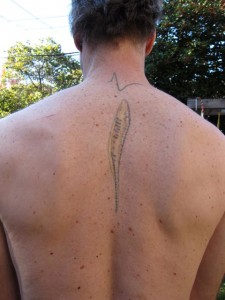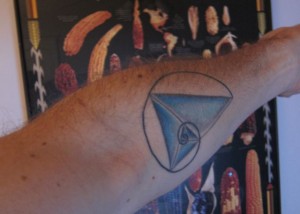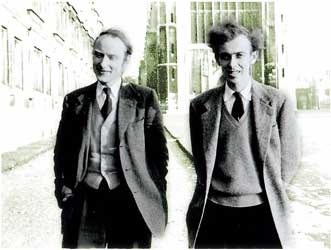Before the holidays, we printed the first part of an exclusive interview with Dick Dorkins, president of SPITOON, the Society for the Prevention of Intelligent design Or Other Nonsense. We now bring you part the second, in which Dorkins discusses religion, atheism, the pioneering work of Project Dick—the effort to sequence and analyze Dorkins’s DNA—and the Dick Foundation, Dorkins’s charity for the genetically underprivileged.
Genotopia (GT): when we finished up last time, you were telling us about the reduplication of your Bub666 gene, the so-called atheism gene.
Dick Dorkins (DD): Ah, yes. To expand, as it were, on the issue: Genetically speaking, I am the strongest atheist the world of science has known. Which is saying something.
GT: Saying what, exactly?
DD: Well, science is full of atheists, of course. It takes some real mental gymnastics to believe in God when you believe in evidence. Anyone with the testicles to confront trilobites, Darwin’s finches, Cro Magnon, and antibiotic resistance must bend over backward to believe in any kind of creator beyond some sort of ethereal, pre-cosmic Big-Banger. Frankly, most of us are just not that flexible.
GT: NIH director Francis Collins manages it.
DD: My point exactly. The Gumby of molecular biology.
GT: Getting back to your genome…
DD: The point is, even among scientists, my depth of lack of faith shines like a beacon. Always has. As a child, my mother took me to hear the music at Midnight Mass on Christmas Eve. My father didn’t attend; while Mom and I sang the Messiah he shuffled through the slush and got sloshed on bubbly at a local pub. My sister Babs says I must have gotten my Bub gene from him.
Anyway, even then, I antagonized the Church. By the age of nine, I had taught myself to sight-read music and I cussedly sang the hymns backward, note for note, over the top of the choir, in my pitch-perfect, pre-pubescent soprano. ‘Hajulellah!’ I’ve been that way all my life. Just ask my wives: I have never been faithful.
GT: And you believe the reason is genetic?
DD: It’s not a matter of faith. To put it simply, I believe the facts show that belief is not factual. This of course is the origin of SPITOON. I founded it with one goal in mind: to snap the suspenders of anyone idiotic enough to see anything even faintly spiritual in our modern scientific world.
GT: How successful have you been? You write learned yet accessible books, you give lectures, you debate creationists—if anyone can persuade the faithful of the folly of their ways, it should be you. How many converts have you won?
DD: To be frank, most religious people tell me my work actually increases their faith–a fact that keeps me awake at night. A Unitarian did write me an email once, saying she was even less likely than before to refer to the god in all of us in the third person. So I take comfort from that.
GT: Let’s get back to your DNA. What else does your sequence reveal? Do you have any of the much-publicized behavioral genes we’ve been reading so much about lately? The violent-drunk gene? The infidelity gene? Thalassophilia?
DD: Infidelity, yes, as I mentioned before. Turns out on that one, the so-called religious right in fact was. Monotheism and monogamy are controlled by the same gene. It’s an old gene, evolutionarily: it goes back to the split between the egg-laying mammals, like the platypus, and the higher mammals, which give birth to live young.
GT: Hang on–are you saying…?
DD: That’s right: monotremes are polyamorous polytheists.
GT: Incredible. What else?
DD: Well, my sequence confirms what I’ve been arguing vehemently all these years: that I am a very peaceful, even a melancholy drunk. I have a single-nucleotide polymorphism, or SNP, associated with a threefold increase in the risk of retreating to a dark corner after three Scotches and regretting my divorce while humming soft hits from the seventies. Unfortunately, I also have an obesity-related allele that predisposes me toward quarts of Ben & Jerry’s. It doesn’t take a geneticist to appreciate the unfortunate synergism between those genes.
GT: What about single-gene diseases?
DD: No Alzheimer’s, thankfully, no cystic fibrosis, no Tay-Sachs, and no Alzheimer’s.
GT: That’s good to hear. Much of the cutting-edge research today, though, is on complex diseases, such as diabetes and cancer. What has Project Dick taught us about them?
DD: My genome has greatly added to our knowledge of basic disease processes that affect millions of people–knowledge that will revolutionize medical care in the twenty-first century. We have discovered dozens of SNPs associated with common disease. For example, I have a fivefold increased risk of nicotine addiction compared to the population as a whole, double the average risk of cancer of the stomach, half the normal level of alcohol dehydrogenase, and a tendency toward dangerously high levels of cortisol when I become excessively fatigued. What’s more, Project Dick has shown that these genes are all involved in a network, so that their effects multiply in combination.
GT: Fascinating! What are the therapeutic implications?
DD: Thanks to my detailed genome profile, I know that I should not smoke, should eat a balanced diet, drink only in moderation, and try to get plenty of rest.
GT: That should silence the critics who say this research is too expensive!
DD: You just can’t put a price tag on your health.
Gt: Another criticism, though, is that, valuable as it is, such medical advice will only benefit those with the willpower to follow it.
DD: Ah, but that is exactly where the biggest impact of genomic medicine will be felt. I *should* eat well, get enough rest, and keep my social vices in check–but the Genetic Virtue Project hasn’t been much of a success yet, has it? Fortunately, I no longer *have* to be virtuous—I just need good drugs. Project Dick has a team of clinicians on staff who are assembling a pharmacological regimen tailored to my genome. It will enable me to live to a spry and vigorous 120 years of age–while gorging myself and partying like there’s no tomorrow. And here is the truly remarkable part: health is simpler than we think. It will probably require only 20 or 30 different medications to achieve hedonistic immortality.
GT: Sign me up!
DD: I take MasterCard, Visa, and PayPal. Seriously, at the moment, in order to sign up you’d have to write me a check for a million dollars. But the cost is dropping faster than blood pressure on statins. Already, you can get a simpler profile–without the crack team of pharmacologists, of course–for a few hundred dollars. And our goal is to incorporate this kind of insight into everyone’s healthcare, right from birth.
GT: Sounds like a medical Plato’s Republic. But who will pay for all of these medications? Some of these drugs get pretty expensive.
DD: The NHS, obviously, at least while the money holds out. You Americans, however, have a much leaner, more efficient system in which healthcare isn’t simply doled out indiscriminately. You people are looking at a revolutionary future in which the ability to indulge without fear of the consequences will be directly proportional to one’s income.
GT: Soon, only the wealthy will be able to afford to eat at Burger King!
DD: That can only be good for the gene pool, don’t you agree? Rather a social Darwinist tit for tat, that one.
GT: Hm. Well, we’re out of time, so, final question: what’s next for Dick Dorkins?
DD: Ah. Well as you know, I have become fantastically wealthy as a result of my book sales and lecture fees. I won’t give hard numbers, but let’s just say that atheism and scientism have been kind to me. And to be honest, I have taken some criticism for profiting from the ignorance and stupidity of others. I think this is uncharitable, and to prove it, The Dick Foundation will be offering what we call Genome Scholarships to the Genetically Underprivileged, or Gizgoos.
GT: The genetically underprivileged?
DD: You catch on fast. Here’s how it will work: Clinicians at elite inner-city teaching hospitals will nominate candidates from their patient populations. Our scholarship committee–a blue-ribbon panel of Nobel laureates, National Academy members, and biotech CEOs–will identify the most genetically needy and provide them with a complete genome scan, a detailed health profile tailored to their needs and abilities, and totally comprehensive lifetime pharmaceutical coverage. Think of it: complete medical management for those who need it most.
GT: Heavens to Galton!
DD: But wait, there’s more. We will also provide the nucleically disadvantaged with the kind of complete high-tech pregnancy management that up till now has been available only to the Lexus-and-Mexican-gardener set. Tools such as in vitro fertilization and prenatal genetic diagnosis. We want those gardeners to be our clients—or, patients, if you will—too.
However, in order to achieve this utopia we must have education. And by education I mean compliance. In that light, we plan to educate Gizgoo winners in the principles of modern molecular health. Through a program of intensive observerships, team-taught technology-based learning, and multiple-choice questions, we will train the molecularly disadvantaged to manage their own health. Our hope is to simplify genome profiling so that someone with an IQ of 70 or a background of ethnicity will be able to identify the medications she needs to stay healthy and to avoid pregnancy. This in turn will lead to a twenty-first century healthcare founded on the principles of preventive medicine—prevention not only of disease but of the people who carry disease. It will truly be a kinder, gentler, healthier society!
GT: Um, Dick?
DD: Hang on, let me grab a Kleenex… OK, shoot.
GT: Hasn’t that been tried?
DD: Ah, but now we know how to do it right.
Like this:
Like Loading...


 Senator Tom Coburn has been attacking what he considers spurious science funded by the National Science Foundation. In a scathing recent report, he skewered grants that supported a robot that folds laundry (an activity recently proven to lead to Nobel Prizes) and taught shrimp how to run on a treadmill. Coburn, who holds a BS in accounting, an MD, and a PhD in BS, knows his science. He
Senator Tom Coburn has been attacking what he considers spurious science funded by the National Science Foundation. In a scathing recent report, he skewered grants that supported a robot that folds laundry (an activity recently proven to lead to Nobel Prizes) and taught shrimp how to run on a treadmill. Coburn, who holds a BS in accounting, an MD, and a PhD in BS, knows his science. He
You must be logged in to post a comment.